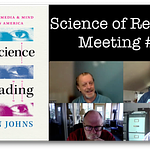This is an essay and a video I created right after the first meeting of my book club. I think it raises some interesting issues regarding the “authority” of authors, where people get their history, and how historians ought to work. I think it’s particularly relevant now, as I’m beginning to think about post-academic lifelong learning communities.
Kathleen, a finance executive from a global corporation, asked an interesting question in the first Book Club Zoom meeting. She said that because the claims Graeber and Wengrow made in The Dawn of Everything are so radical and revisionist, she was unsure how much to trust them. She asked, and someone made a page in the vault looking for information on "Evaluation tips for non-historians". This is something I've been thinking about for a while, in the context of all the trade press books dealing with history that are written by non-historians for a general audience. When you think about it, more people get their historical (even revisionist) ideas from people like Charles Mann (1491), Yuval Harari (Sapiens), Jared Diamond (Collapse), or even Nassim Nicholas Taleb (The Black Swan). So how do these authors gain "authority"? And how do actual professionals compete with an understanding of technical fields they develop by reading popular books and articles?
One of the reasons many journalists are drawn to writing history, of course, is that many of the research, analytical, and narrative techniques are very similar. Both fields have standards of evidence that include corroboration from multiple sources and critical analysis of the perspective and interests of the people that produced that evidence. It's possible, of course, to uncritically accept old written documents just because they're old or because they say what a historian is expecting to hear. That's a pitfall history shares with contemporary journalism. Historians generally have been trained to understand that, as Chris Aldrich said in yesterday's Book Club meeting, we're all swimming in our cultural waters and are influenced by them, even if we don't notice it. This is the basic gist of the "post-modern" critique, and even if not everyone believes that language and culture are *determinative*, pretty much everyone agrees they are influential. (This distinction between definite cause and influence, between 100% agreement and 0% disagreement, is another idea that came up in the Zoom discussions, but I'll cover that separately)
Chris mentioned on the "Evaluation tips" page that citing primary sources is important in establishing an analysis and being believed. I agree, and I want to point out that there's an expectation that in "good history" (or probably good anything else) reading and understanding primary sources precedes interpretation. We're not supposed to be drawing a curve on the graph and THEN going out looking for data points to fit to it. Ironically, I think this may contribute to the initial distrust several readers expressed about the claims G&W make in the opening chapters. The evidence they present lines up just a bit too neatly with the story they clearly want to tell. I listened to a bit of the first chapter as I was winding down for bed last night, and they do say that they are just sketching the very first outline of a picture that it will take a lot more work to fill in. Maybe part of the distrust has to do with the shock of discovering that the data supporting this revisionist interpretation has to a great extent been hiding in plain sight.
I think it may have been the British Library interview in which Wengrow says something like, you know, no one ever challenges a new conservative book and says, so and so has just offered a neoliberal perspective on X. But when an anarchist says something, people are sure to spend most of their time remarking on his politics. I think it's relevant that G&W call out Pinker's cherry-picking of Ötzi the ice man. They counter this with the Romito 2 specimen, but they insist that it is no more conclusive than Ötzi. So how does a challenging new interpretation gain ground in the face of an entrenched dominant narrative?
Other ways authors instill trust in their claims include showing their work. It's unfortunate that modern editors hate footnotes and require endnotes. This virtually guarantees that a lot of supporting data and interpretation are going to be missed by readers who don't go looking for them. G&W use discursive notes, which expand on the points they've made in the text and often comment on the sources they cite. A reader concerned with the trustworthiness of their evidence and interpretation will gain a lot from checking these. Primary sources are sometimes harder to verify, which is why it's important, for example, that a number of French sources mention how impressed they were with natives such as Kandiaronk and depict the Indian critique of European culture in similar terms (even the Jesuits, who were not particularly sympathetic). With secondary sources, I like to check and see what the author is doing with the information. It's standard to refer to interpretations that agree with yours, but often even more interesting when the new interpretation is arguing with, modifying, or "complicating" the previous one.
And this brings me to the biggest factor I look for: engagement with other scholarship. I'm just coming off teaching a semester of undergraduate historiography, which is all about the ways the discipline of history has changed over time. Every serious (academic) historical work includes a conversation with other scholarship, and this has largely carried over into popular historical writing. Often this makes interesting reading in its own right. Mann's 1491, for example, includes a long passage on the generational argument among scholars about the habitability of the Amazon region that examines not only the new evidence that has influenced changing interpretations but the professional, personal, and political factors involved in revisionism and resistance. G&W may be a bit less focused on this in the initial chapters than they might have been. But they both have a long history of engaging with their peer groups in anthropology and archaeology. The article that preceded the book ("Farewell to the 'childhood of man': ritual, seasonally, and the origins of inequality" has been cited 57 times since 2015.




















How Can I Believe You?